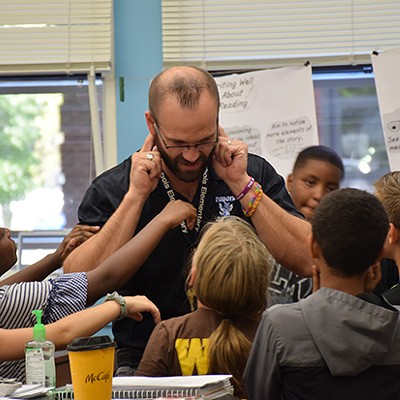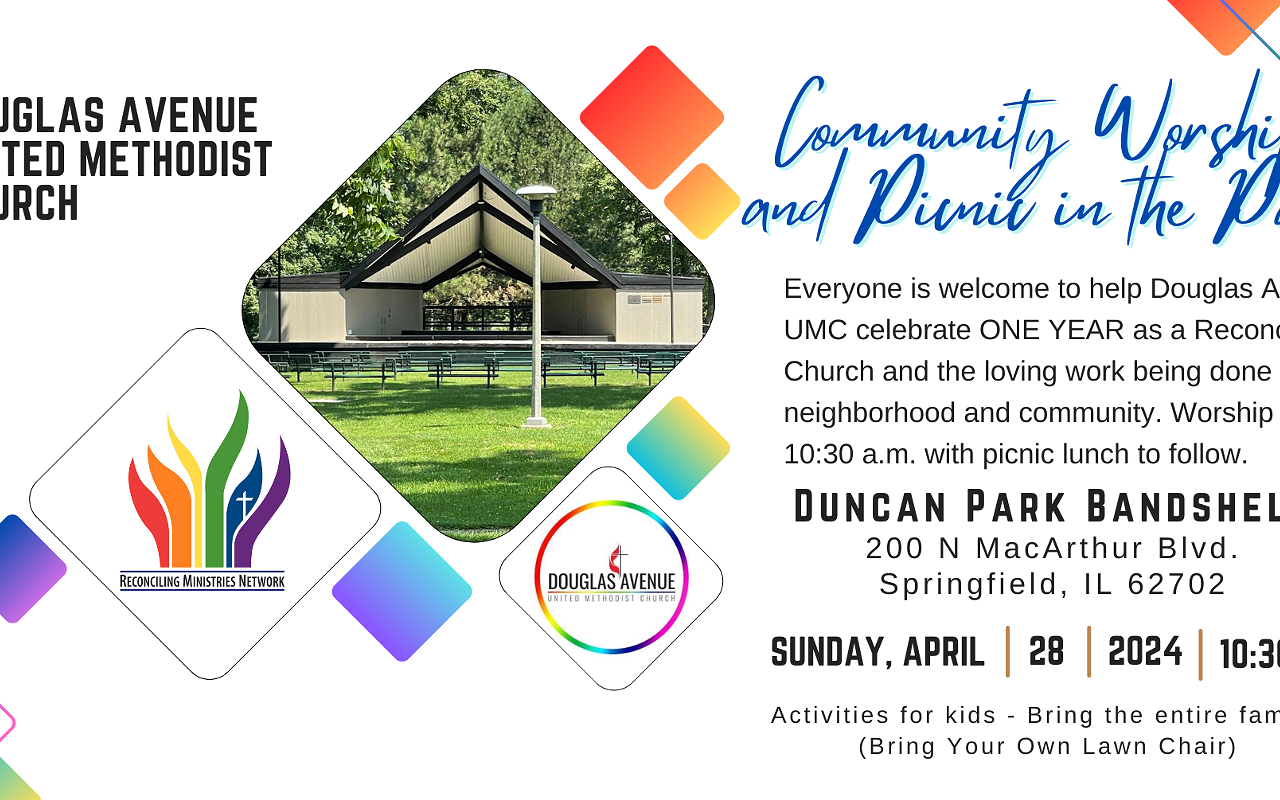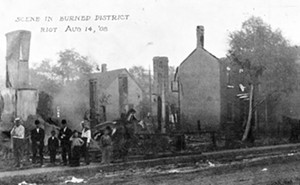
When Floyd Mansberger and Christopher Stratton at Fever River Research began their archaeological investigation of 10th Street between Madison and Mason streets in Springfield, they knew the probability was high that they would uncover something significant. Thanks to extensive archival research on this particular site, they had a good idea of who had occupied this block, and why those occupants left. The only question was the status of the site’s integrity, and to what degree the material record would corroborate the written record.
And then, with a few scrapes of the backhoe against the test area, they found it. The foundation of a humble house, which had been home to several working class families over the 60-odd years it stood at that spot. And within the foundation, under a thin layer of yellow silt loam, was the ash that had been deposited the night of Aug. 14, 1908, when that house was burned down by an angry mob during the Springfield race riots. Further excavation revealed the foundations of seven houses, five of which had evidence of being destroyed by fire.
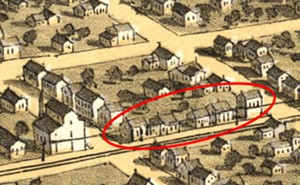
Rail consolidation triggers discovery
The houses were excavated as part of the Springfield Rail Improvements Project to consolidate all railroad passenger and freight traffic from the Third Street corridor to the 10th Street corridor in an effort to reduce congestion, improve safety and enhance livability in Springfield. The consolidation effort is being led by the City of Springfield, in cooperation with Sangamon County and the Illinois Department of Transportation, and managed by Hanson Professional Services, Inc.
One aspect of the consolidation project involves the construction of eight underpasses designed to relieve automobile congestion at railroad crossings. Work began on the first of these underpasses, at 10th and Carpenter streets, after the adjacent land was acquired from St. John’s Hospital in the fall of 2014. The scope of work includes lowering Carpenter Street between Ninth and 11th streets, constructing dual-track railroad bridges, and completing three blocks of draining, grading and sub-ballast south of Carpenter Street.
Because the consolidation project relies in part on federal funds ($152 million of the estimated $315 million price tag), it must obey federal environmental planning and historic preservation laws, including Section 106 of the National Historic Preservation Act, which requires that projects receiving federal funds consider effects on historic properties.
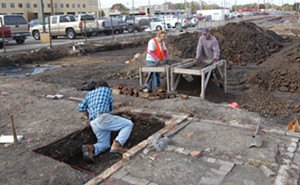
In compliance with Section 106, Hanson contracted Fever River Research to do a Phase I archaeological survey of the land associated with the Carpenter Street project to determine the site’s potential for intact archaeological resources. This initial survey consisted of extensive archival research into maps, census records, city directories and chains of title to determine the history of occupancy on the site.
Mansberger quickly realized that the area under investigation included the sites of several houses in the area devastated by the Springfield race riots in 1908.
“Our archival research suggested there were a series of houses there that had been destroyed by the race riots. The only question was, would they be undisturbed and intact?” he explained.
Based on their research, the Fever River team identified multiple areas where historic structures had been documented, subsequent ground disturbance appeared to be minimal and the research potential was high. In consultation with the Illinois Historic Preservation Agency, it was decided that these areas would be subjected to further archaeological investigation.
At the first test area (Block 3), located along 10th Street between Mason and Madison streets, Phase II investigation of the site began with the excavation of a single backhoe trench. As soon as the trench was opened, however, Mansberger and Stratton discovered the intact structural remains of seven houses. The investigation broadened to a larger block excavation. Each house was mapped, and at least one test unit was dug by hand at each house to assess the depth of the archaeological deposits, the presence or absence of cellars and the nature of the fill deposits in each house.
The second test area (Block 14), located between Mason and Reynolds streets, was subjected to a similar investigation. A backhoe was used to strip the top layer of soil, revealing the remains of two structures dating to the mid-19th century, as well as several privy pits at the rear of the lot lines. Ten of these privy pits were sampled.
The fragments of the past that are coming to light at these sites paint a fascinating and dynamic picture of the transformation wrought by social changes in 19th century Springfield.
“It’s the story of an evolution of an urban environment in Illinois,” Mansberger said. “From a white working class area to an integrated neighborhood to a neighborhood in decline.”
And ultimately, to the destruction of that neighborhood, during one of the darkest chapters of Springfield’s history.
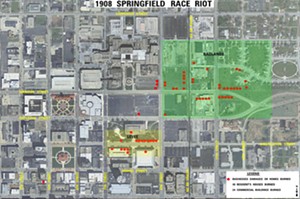
Evidence of a dynamic neighborhood
The small houses along 10th Street that ended their existence as dilapidated shacks torched by an angry mob started as the tidy dwellings of upwardly mobile white working class families built in the 1840s and 1850s. The near north side neighborhood in which they were located offered affordable housing that was close to the central business district. The residents of this neighborhood were a mix of native-born Americans as well as German and Irish immigrants. Many of them were tradesmen (cabinetmaker, hatter, etc), while others worked as millers or firemen at the nearby Phoenix Mill. Two of the houses were likely constructed by John Roll, a local building contractor, and operated as rental properties. Roll was a friend of Abraham Lincoln’s who had also done work on Lincoln’s house. In 1861, the Lincoln family left their dog, Fido, with Roll, who had small sons near Willie and Tad’s age.
A little to the north, in Block 14, were the homes of several Portuguese families, in an area representing the southern extension of a near north side neighborhood known as “Little Madeira.” After fleeing religious persecution in their home island of Madeira, several hundred Portuguese emigrants settled in Springfield between 1849 and 1852. “Little Madeira” was one of the earliest and largest Portuguese settlements in the Midwest [see “When Springfield took in Portuguese refugees,” by Erika Holst, IT, Sept. 24].
The project area includes the archaeological remains of two structures. One is a residence built as a single-family home in the mid-1850s and converted to a duplex by c. 1860 on a lot owned by Portuguese immigrant Mary Ferreira. The second is a two-story frame structure that housed a grocery store on its first level and residential quarters on the second floor. The grocery story was likely built by Portuguese immigrants John and Manuel Mendonca around 1867.
Although the structural integrity of the duplex and the grocery store has been compromised by 20th century construction, the lots on which they sit show evidence of several suspected privy pits. Because privy pits served as garbage receptacles in the 19th and early 20th centuries, these features have the potential yield and exciting array of artifacts that would provide a wealth of information on the early life and foodways of this ethnic population.
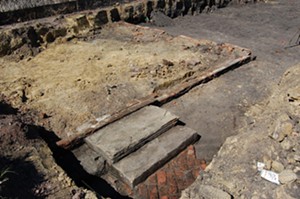
Orgy of violence
By the late 19th century, the neighborhood represented in the archaeological project area was in decline, comprised of aging and dilapidated low-income houses, many of which stood vacant. It was in an area of town known as the “Badlands,” populated by poor African-Americans and immigrants. There, in the sweltering heat of August 1908, long-simmering racial tensions erupted into an orgy of violence and destruction that reduced more than 40 black-owned homes and businesses to smoldering heaps of ash.
Tension had been building in Springfield for years before the race riots broke out. Springfield’s factories and coal mines drew a large influx of Southern blacks to the city; native-born white American and European immigrants alike resented black competition for blue-collar jobs. And in an era where whites clung to rigid ideas of social and racial hierarchy, the arrival of a large influx of blacks seemed to threaten white social and economic dominance.
This simmering racial tension reached the boiling point on Aug. 13, 1908, when 21-year-old Mabel Hallam claimed that a black man had crept into her home, dragged her from her bed and assaulted her. She identified her assailant as 36-year-old George Richardson, a laborer who had been working in Hallam’s neighborhood. Despite Richardson’s protests that he had been at home with his wife when the attack took place, he was arrested and taken to the Sangamon County jail.
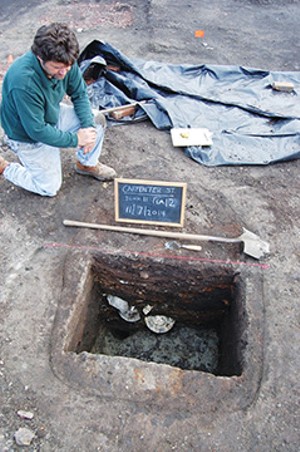
On Aug. 14, not long after Richardson’s arrest, a vengeful crowd gathered outside the jail building, their mood growing darker as the hours crept by and the mercury in the thermometer rose. Knowing that there was a real possibility the crowd might try to forcibly drag Richardson out and lynch him, the sheriff, Charles Werner, arranged to have Richardson and another black prisoner spirited out of the jail and put on a northbound train to Bloomington.
The crowd’s temper was not improved by the realization that the objects of their vengeance had been spirited away. They milled about uncertainly for a time, then were energized by the news that restaurateur Harry Loper had loaned his car as the getaway vehicle. With shouts and threats, the crowd made its way south to Loper’s restaurant.
After an hour-long standoff with Loper, who stood in the door of his restaurant with a loaded rifle, violence erupted. Loper’s car, parked in front of the restaurant, was turned over and set ablaze. A brick was sent crashing through the restaurant’s plate glass window. Amid shouts of “curse the day that Lincoln freed the niggers,” the mob rushed into Loper’s establishment and utterly demolished it, smashing tables chairs, plates, glasses and mirrors.
The flame of violence, once ignited, was not readily extinguished. From Loper’s restaurant, the crowd moved on to the Levee, a red-light commercial district along East Washington Street which housed several black-owned businesses. There they laid waste to whole blocks of black-owned businesses, being careful to spare property owned by whites. The Journal reported that “within a short time the east end of the levee was the scene of a brilliant illumination which cast its baleful glare over the entire city.” When firemen tried to put out the blaze, the mob promptly cut their hoses. Weapons were fired with impunity, resulting in dozens of injuries and a handful of deaths.
Finally, the mob moved on to the Badlands, where it continued its hellish devastation. Torches were applied to black-owned homes, while those of whites (indicated by white handkerchiefs) were spared. According to the Journal, “terror-stricken men and women rushed from the houses and fled for their lives, with frenzied whites in wild pursuit.” A black barber named Scott Burton was beaten senseless, dragged from his home, and lynched from a dead tree; his body was then riddled by bullets and slashed by knives.
By the time the riots were finally quelled by the state militia on Saturday, Aug. 15, two black men had been killed by the mob, five white men had died of wounds sustained during the melee and more than 100 people had been injured.
One of them was a black man named William Smith, of 301 N. 10th St. The newspaper reported that Smith was “tied to telegraph pole and face beaten to jelly.” The foundation of the house where Smith lived was one of those unearthed by the Carpenter Street underpass archaeology. The stoop across which Smith was dragged from the safety of his home by a violent mob survives, preserved under the earth for more than a century. Deposits of ash and charred artifacts within the foundation testify that Smith’s house was destroyed by fire even as he underwent physical assault in the riots.
In the aftermath of the riot, the Journal reported that “on both sides of 10th Street north of Madison Street, there were a row of huts, which were destroyed by the torch of the mob.” Thanks to archaeological investigation of the Carpenter Street underpass, we know that there were five houses in that row, plus two adjacent that escaped destruction. These sites, undisturbed archaeologically for more than a century, represent a horrific moment frozen in time.
“The fact that this block largely was cleared of housing in one devastating event and never reoccupied, presents a unique opportunity to examine one enclave of African-American residents at one pivotal point in time,” Mansberger and Stratton wrote in the site’s executive summary. “The houses and their contents can be considered part of the forensic evidence of what was in essence a crime scene.”
The future of the site
For now, excavation at the sites has halted. The features were filled with sand and covered with geotextile fabric to prevent erosion and the site is fenced and monitored by security cameras. These actions were taken on the recommendation of the Illinois Historic Preservation Agency to secure the site until a federally mandated consultation process determines appropriate treatment or mitigation for the cultural resources contained within.
The significance of the findings at the Carpenter Street underpass site means that the project area meets criteria A and D for inclusion on the National Register of Historic Places as defined by the National Park Service. Criterion A includes places “that are associated with events that have made a significant contribution to the broad patterns of our history.” This criterion is met by the site’s association with the Springfield race riots, which had a direct role in the formation of the National Association for the Advancement of Colored People (NAACP) the following year. Criterion D, which includes places “that have yielded, or may be likely to yield, information important in prehistory or history,” is met by the site’s potential to reveal material evidence of the evolution of an urban environment as well as the race riot.
Because it meets these criteria, the site is currently subject to the review process stipulated by Section 106 of the National Historic Preservation Act. Major participants in the Section 106 process include the Federal Railroad Administration, the Illinois Historic Preservation Agency, the City of Springfield and the federal Advisory Council on Historic Preservation.
As part of the review process, a series of open meetings were held to give members of the public a chance to learn about the project and provide their views. Individuals or organizations with a demonstrated interest in the project were invited to become “consulting parties,” who will be involved in the plans for the management of the site’s cultural resources as the rail consolidation goes forward.
Kevin Seals, chief environmental scientist at Hanson Professional Services, explains: “When you have a protected resource, you want to first avoid [impacting] it, then minimize the impact on it, then mitigate for it. If impact can’t be avoided or minimized, then we would mitigate.”
Rev. T. Ray McJunkins, pastor of the Union Baptist Church and cofounder of the Faith Coalition for the Common Good, is dismayed by the prospect of the archaeological site being destroyed by railroad tracks.
“In that case, there’s nothing you can do to memorialize this as an historical site. When someone wants to visit this site, all they would see would be railroad tracks,” he said. McJunkins would like to see further excavations done on the site and the planned tracks adjusted to accommodate the site.
“Let us not forget the history of Springfield. The race riots are a part of that history. More should be done to interpret that story than a marker placed at a site that isn’t even the actual site of the event,” McJunkins said.
As currently conceived, the 10th Street rail consolidation plans call for the new railroad right of way to go directly over the seven excavated house foundations. The “consulting parties” sent a letter to Union Pacific asking the railroad to alter its footprint to avoid the archaeological features. They are still awaiting a response.
In the meantime, the “consulting parties” are weighing in on the best course of action to protect the site, mine its information and share that information with the public.
Frank Butterfield, Springfield field office director for Landmarks Illinois, said “Through community engagement and the consultation process, we hope to find a solution that minimizes disturbance to this historically significant site. Our local partners continue to explore ways to protect, share and interpret the archaeological site and the information that has been gathered from this ongoing process.”
Suggestions include erecting a historical marker on the site, conducting further archaeological excavations of the site, and creating a traveling exhibition of artifacts recovered from the site.
Fortunately, the archaeological site is in no immediate danger. Construction of the railroad right of way will not begin until all eight underpasses have been built, a process which will take several years. Because the archaeological discoveries are several blocks away from the Carpenter Street Underpass, work on that project is proceeding on schedule.
Ultimately, the city of Springfield has reaped cultural benefits from the railroad consolidation project because of its use of federal funds. Had the site in question been under private development, the cultural resources it contained could easily have been destroyed with no one being the wiser.
As it is, the excavation has brought to light new information on the evolution of Springfield as a 19th century urban environment as well as on a pivotal, if tragic, moment in this city’s history.
Erika Holst is an historian and author. She is Curator of Collections at the Springfield Art Association.




